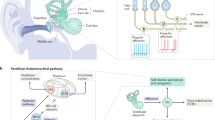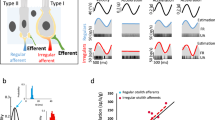Abstract
During self-motion, the vestibular system makes essential contributions to postural stability and self-motion perception. To ensure accurate perception and motor control, it is critical to distinguish between vestibular sensory inputs that are the result of externally applied motion (exafference) and that are the result of our own actions (reafference). Indeed, although the vestibular sensors encode vestibular afference and reafference with equal fidelity, neurons at the first central stage of sensory processing selectively encode vestibular exafference. The mechanism underlying this reafferent suppression compares the brain’s motor-based expectation of sensory feedback with the actual sensory consequences of voluntary self-motion, effectively computing the sensory prediction error (i.e., exafference). It is generally thought that sensory prediction errors are computed in the cerebellum, yet it has been challenging to explicitly demonstrate this. We have recently addressed this question and found that deep cerebellar nuclei neurons explicitly encode sensory prediction errors during self-motion. Importantly, in everyday life, sensory prediction errors occur in response to changes in the effector or world (muscle strength, load, etc.), as well as in response to externally applied sensory stimulation. Accordingly, we hypothesize that altering the relationship between motor commands and the actual movement parameters will result in the updating in the cerebellum-based computation of exafference. If our hypothesis is correct, under these conditions, neuronal responses should initially be increased—consistent with a sudden increase in the sensory prediction error. Then, over time, as the internal model is updated, response modulation should decrease in parallel with a reduction in sensory prediction error, until vestibular reafference is again suppressed. The finding that the internal model predicting the sensory consequences of motor commands adapts for new relationships would have important implications for understanding how responses to passive stimulation endure despite the cerebellum’s ability to learn new relationships between motor commands and sensory feedback.

Similar content being viewed by others

References
Popa LS, Hewitt AL, Ebner TJ. The cerebellum for jocks and nerds alike. Front Syst Neurosci. 2014;8:113.
Krakauer JW, Mazzoni P. Human sensorimotor learning: adaptation, skill, and beyond. Curr Opin Neurobiol. 2011;21:636–44.
Shadmehr R, Smith MA, Krakauer JW. Error correction, sensory prediction, and adaptation in motor control. Annu Rev Neurosci. 2010;33:89–108.
Tseng YW, Diedrichsen J, Krakauer JW, Shadmehr R, Bastian AJ. Sensory prediction errors drive cerebellum-dependent adaptation of reaching. J Neurophysiol. 2007;98:54–62.
Galea JM, Vazquez A, Pasricha N, de Xivry JJ, Celnik P. Dissociating the roles of the cerebellum and motor cortex during adaptive learning: the motor cortex retains what the cerebellum learns. Cereb Cortex. 2011;21:1761–70.
Cullen KE. The neural encoding of self-motion. Curr Opin Neurobiol. 2011;21:587–95.
Roy JE, Cullen KE. Dissociating self-generated from passively applied head motion: neural mechanisms in the vestibular nuclei. J Neurosci. 2004;24:2102–11.
Sawtell NB, Bell CC. Adaptive processing in electrosensory systems: links to cerebellar plasticity and learning. J Physiol Paris. 2008;102:223–32.
Bauswein E, Kolb FP, Leimbeck B, Rubia FJ. Simple and complex spike activity of cerebellar Purkinje cells during active and passive movements in the awake monkey. J Physiol. 1983;339:379–94.
Blakemore SJ, Frith CD, Wolpert DM. Spatio-temporal prediction modulates the perception of self-produced stimuli. J Cogn Neurosci. 1999;11:551–9.
Jenmalm P, Schmitz C, Forssberg H, Ehrsson HH. Lighter or heavier than predicted: neural correlates of corrective mechanisms during erroneously programmed lifts. J Neurosci. 2006;26:9015–21.
Batton 3rd RR, Jayaraman A, Ruggiero D, Carpenter MB. Fastigial efferent projections in the monkey: an autoradiographic study. J Comp Neurol. 1977;174:281–305.
Carleton SC, Carpenter MB. Afferent and efferent connections of the medial, inferior and lateral vestibular nuclei in the cat and monkey. Brain Res. 1983;278:29–51.
Brooks JX, Cullen KE. Early vestibular processing does not discriminate active from passive self-motion if there is a discrepancy between predicted and actual proprioceptive feedback. J Neurophysiol. 2014;111:2465–78.
Berniker M, Kording K. Estimating the sources of motor errors for adaptation and generalization. Nat Neurosci. 2008;11:1454–61.
Proville RD, Spolidoro M, Guyon N, Dugué GP, Selimi F, Isope P, et al. Cerebellum involvement in cortical sensorimotor circuits for the control of voluntary movements. Nat Neurosci. 2014;17(9):1233–9.
Conflict of Interest
There are no potential conflicts of interest in our submission.
Author information
Authors and Affiliations
Corresponding author
Rights and permissions
About this article
Cite this article
Cullen, K.E., Brooks, J.X. Neural Correlates of Sensory Prediction Errors in Monkeys: Evidence for Internal Models of Voluntary Self-Motion in the Cerebellum. Cerebellum 14, 31–34 (2015). https://doi.org/10.1007/s12311-014-0608-x
Published:
Issue Date:
DOI: https://doi.org/10.1007/s12311-014-0608-x



